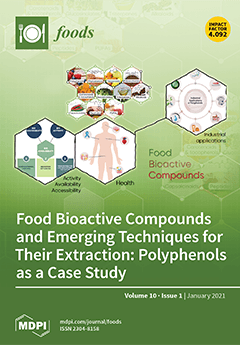Pyrethroid pesticides are widely used on tea plants, and their residues of high frequency and concentration have received great attention. Until recently, the residues of typical metabolites of pyrethroid pesticides in tea were unknown. Herein, a modified “quick, easy, cheap, effective, rugged and
[...] Read more.
Pyrethroid pesticides are widely used on tea plants, and their residues of high frequency and concentration have received great attention. Until recently, the residues of typical metabolites of pyrethroid pesticides in tea were unknown. Herein, a modified “quick, easy, cheap, effective, rugged and safe” (QuEChERS) method for the determination of three typical metabolites of pyrethroid pesticides in tea, using ultra performance liquid chromatography tandem mass spectrometry, was developed. The mixture of florisil, octadecylsilane, and graphite carbon black was employed as modified QuEChERS adsorbents. A Kinetex C18 column achieved good separation and chromatographic peaks of all analytes. The calibration curves of 3-phenoxybenzoic acid (3-PBA) and 4-fluoro-3-phenoxybenzoic acid (4-F-3-PBA) were linear in the range of 0.1–50 ng mL
−1 (determination coefficient R
2 higher than 0.999), and that of
cis-3-(2-chloro-3,3,3-trifluoroprop-1-en-1-yl)-2,2-dimethylcyclopropanecarboxylic acid (TFA) was in the range of 1–100 ng mL
−1 (R
2 higher than 0.998). The method was validated and recoveries ranged from 83.0% to 117.3%. Intra- and inter-day precisions were lower than or equal to 13.2%. The limits of quantification of 3-PBA, 4-F-3-PBA, and TFA were 5, 2, and 10 μg kg
−1, respectively. A total of 22 tea samples were monitored using this method, and 3-PBA and TFA were found in two green tea samples.
Full article






